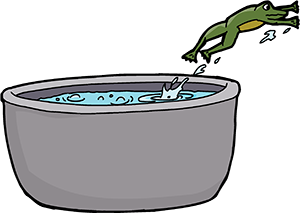By John Daniel
Many of us have heard the parable of the boiled frog. If you drop a frog into a pot of boiling water, it will jump out. But if you put a frog in warm water and slowly bring it to a boil, the frog will not sense the danger until it is too late. Consequently, the frog is boiled alive.
While modern science has challenged the premise of the 19th century experiments that created the tale, the lesson of the boiled frog lives on. It has become a metaphor to remind us to be aware of the impact of gradual change. Our brain is actually wired to sense and react to sudden and dramatic change. When it senses danger neurons fire, neurotransmitters are released and we find the focus and energy to save the day. It is the incremental, almost imperceptible changes that creep up on us and get us in trouble.
How do human resources professionals avoid becoming boiled frogs? First, we must become proactive in monitoring and reflecting on the long term forces that are impacting our businesses and our profession. In this article I focus on three trends that have been impacting us for some time and may be accelerating.
| FROM | TO |
| Periodic performance evaluation | Ongoing, real time performance coaching |
| Structured learning | Constant learning |
| Hierarchical/Vertical organizations | Agile, team oriented work |
Performance Coaching
Many companies have eliminated performance ratings and some are moving completely away from annual performance reviews. For decades our profession was founded on a belief that annual performance evaluations were key to company performance. However, over the last decade, research in neuroscience and cognitive psychology has shown that evaluation can have a powerful negative effect on employees. Evaluation puts our brain in a threat state and therefore reduces our ability to learn, solve problems and think creatively.
On the other hand, well designed performance coaching improves confidence and skills and leads to improved productivity and performance. Look for a continuation of the trend away from annual reviews to periodic check-ins and away from ratings, with a focus on past performance, to high quality coaching conversations focused on the future. Evaluation still has an important role in managing our employees but it should be a separate process and tied to the compensation and reward systems.
Constant Learning
In my early days in human resources, almost all training occurred in a classroom setting. The learning experience was trainer led, away from the office and conducted during specific time frames. With the introduction of technology, more training has been moved online. New learning delivery models like manager led facilitation, learning communities and tools like learning maps have transformed training delivery.
In the last decade, research in neuroscience has led to discoveries on the role of the hippocampus and the neurotransmitter dopamine on learning and retention. A key finding of this research is that brief bursts of focused attention and spacing, or distributing learning over time, are important for high impact learning. In summary, look for acceleration of the trend in self-paced learning and the increased use of technology like mobile learning apps and virtual reality.
Becoming More Agile
The growth of knowledge is exponential. It is believed that until 1900 human knowledge doubled approximately every century. In the twentieth century knowledge doubled every twenty five years. Today, knowledge is doubling every year and, in some specific technology areas, every twenty four hours. This growth in knowledge is forcing specialization and sub specialization at unprecedented levels and is forcing a rethinking in the way we organize work.
In the past, in large organizations, most knowledge rested at the top. Hierarchy and top down decision making worked well. Today a leader is not the one who knows the most but one who facilitates a team of experts and specialists to discover the best result. Traditional vertical organizational structures have the benefit of organizing work effectively and creating career paths and learning synergies, but they slow down decision making and stifle creativity.
In a world of vast knowledge and specialization, the key to organizational success is to push decision making down in the organization and organize work around teams that cross the organization horizontally. For example, product development happens with a team made up of product, marketing, technology, legal etc. The team comes together, completes the task then disperses. This way of working is already the norm in many organizations. Look for it to continue to expand as the predominant way of working.
In the past few decades, the world of IT has developed and refined a method of software development called Agile. Its success in improving the speed and quality of software has inspired the spread of agile outside of IT and across the organization.
Agile is both a mindset and formal method of working. The implication for human resources are profound and beyond the scope of the article. One example is HRIS architecture which is organized around hierarchies, not teams. In organizations experimenting with Agile, HR professionals are struggling with how to place, track and monitor talent. Our current systems limit flexibility and will need to adapt. The underlying forces are powerful and I expect all of us will soon be speaking of scrums, sprints, stand ups and the rest of the languages and tools of Agile.
In Conclusion
The three trends mentioned above are only a few of many. HR professionals need to be proactive and intentional about monitoring the forces impacting us or else be overwhelmed by them. In other words, be careful not to become a boiled frog.

John Daniel, Chief HR Officer
First Horizon
jdaniel@firsthorizon.com
www.firsthorizon.com
